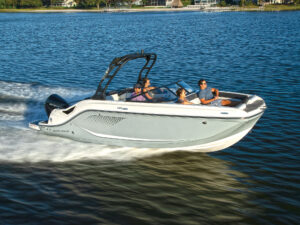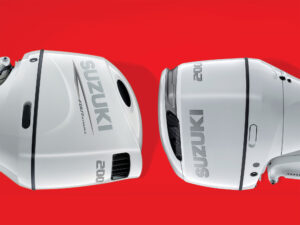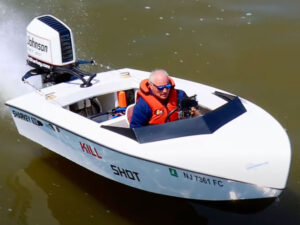Many stern-drives have flexible gaskets, called “bellows,” that seal the water out where the universal joint, shift cable and exhaust run between boat and drive. Their flexibility allows the drive to trim and turn while under way, but they can dry out and crack due to heat, harsh weather or age. In fact, since you can’t apply antifouling to flexible rubber like a bellows, marine growth, especially barnacles, can create a tear. Specific replacement procedures vary by model, but knowing the basic steps can empower you to change the bellows yourself, or at least to be a better negotiator when the time comes to do the deed.
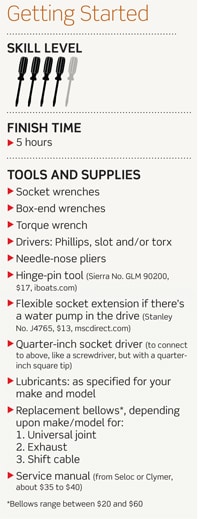
Step 1. Get the service manual for your drive and identify which fasteners, clips and gaskets to remove and in what order. The factory manual is best bought from your dealer, but Clymer (clymer.com) and Seloc (selocmarine.com) publish aftermarket manuals for about $35.
Step 2. Remove the prop, then the drive. It’s easier if you have a friend to help, but if working solo, support the drive as it slides out using a hoist or a 1/2-inch diameter line tied to the rafters or a stout tree limb. Hit the shaft on the ground and you could bend it. A hoist ring with a half-inch diameter and 13 threads, available at hardware stores, can be screwed into the lube-oil level tube on some drives; others have a lifting ring welded on beneath the cowl. You can order the proprietary part as specified in your service manual.
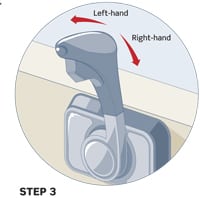
**
Step 3.** If the drive is right-hand, put the shift lever in reverse; if it’s left-hand, put it in forward; if it’s a dual-prop drive, refer to your service manual. Now disconnect the shift cable at the engine. That done, remove the toggle at the cable end, leaving the straight-threaded rod so you can pull it through the transom.
Step 4. Disconnect the trim limit switch on the portside of the upper housing by removing the screws that secure it. Allow it to dangle on its cable, taping it off on the transom.
Step 5. Remove the hinge pins, if equipped, using a hinge-pin tool chucked in a socket wrench. These are often very hard to remove. Lubricant spray may be required. Don’t just lean on the wrench — “work” the fastener; don’t break it off.
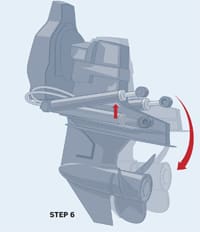
Step 6. Disconnect the trim cylinders, undoing the fasteners that secure them. Be prepared to support these so they don’t hang on the hydraulic lines. One way to do this is to run a line through the connecting rings on the cylinders and to tie each end of the line to a transom cleat.
Step 7. You may have to remove the water-pump clamp for drives with the pump in the drive instead of on the engine. If you do, a flexible socket tool will prove most helpful and, indeed, quite necessary.
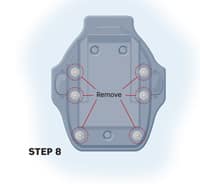
Step 8. Remove the nuts and bolts securing the drive to the transom assembly. There are typically six of these. The drive may stick, in which case tilt it up a few inches and let it drop (holding on to it, of course) a few times. This usually breaks it free. Now pull it straight out.
Step 9. If you have twin drives, label them so that you don’t get them mixed up and reverse them on re-installation.
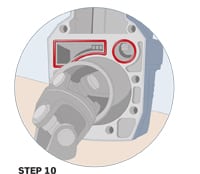
Step 10. Refer to your service manual for a unique tool or special tip that would allow you to remove the U-joint bellows (and shift cable and exhaust bellows, if applicable). Follow that advice and remove it. Replace with a new one. Replace all other O-rings and gaskets (might as well while the drive is apart). You’ll use a different lubrication on the fasteners and gaskets and the O-rings, depending on the make and model, so check the book.
Step 11. Refasten the parts you took apart, torquing to specifications and lubing as indicated in your service manual.
Step 12. Reconnect cables and hydraulic hoses, topping off and bleeding the system.
Step 13. Do it again next year. Inspect the bellows annually and replace it every two years. Many, myself included, feel that if the drive is removed for inspection, you may as well just replace the bellows while you’re at it. It’s cheap insurance. Some drives, like Volvo Penta’s OceanX, have a sensor in the bellows to alert you to the presence of water.
And don’t forget...
While the drive is off, check the following:
-Engine alignment, with special tool specified in your manual. Adjust as necessary.
-Condition of gimbal bearing, which should turn freely with no tight spots or binding.
-The U-joints, which should move freely. Lube them if they have grease fittings; replace if they’re tight or binding or have rough spots.
-The exhaust bellows (if equipped) and water intake hose, which need to be replaced if there are any signs of deterioration.
-The propeller(s), which should be removed, cleaned and sent out for reconditioning if nicked or bent, and the prop shaft, which should be greased. Also change gear lube.

